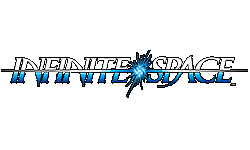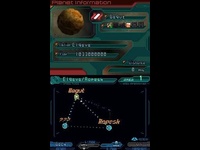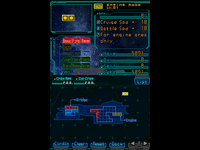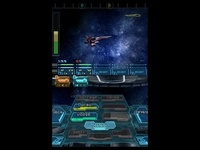|
|

|
PLATFORM
|
DS
|
BATTLE SYSTEM
|

|
INTERACTION
|

|
ORIGINALITY
|

|
STORY
|

|
MUSIC & SOUND
|

|
VISUALS
|

|
CHALLENGE
|
Moderate
|
COMPLETION TIME
|
40-60 Hours
|
|
OVERALL

|
+ Vast game with lots to explore and do
+ Intriguing, addicting tale
+ Ship modules are numerous and varied
+ Enormous incentive to replay
- Sudden difficulty spikes are disgruntling
- Upgrades are often too expensive
|
Click here for scoring definitions
|
|
|
Putting the development studios Nude Maker and Platinum Games together might seem like a recipe for the first Adult Only RPG on the DS, but Infinite Space does not dilute its science-fiction by doing so. The game strings together a variety of concepts that are not commonly seen in Japanese RPGs, weaving a gripping and cohesive narrative along the way. It has unmistakable faults, but these are decisively outweighed by the things done right.
Infinite Space's plot begins when a young man named Yuri is launched into space, courtesy of a woman named Nia Lochlain. Her job is taking people who live on worlds that forbid space travel away from their grounded existences, provided they can pay the necessary fee. Yuri's goal is to become a Zero-G dog, the title granted to those who make a life of traveling the stars and never being tied to any location. Yuri's plans are altered somewhat by the need to rescue his sister Kira from the ruler of his former planet. She joins Yuri after this is done, and his fame gradually grows as he becomes deeply enmeshed into the workings of the Small Magellanic Cloud system, a loose-knit confederation of nations that is unable to unite when an outside force makes its acquisitive tendency felt.
The game may begin with one of the big Japanese RPG clichés, a teenage male hero heading on a journey with a female to prove himself, but Yuri rises above cliché to become an interesting character whose journey is gripping to follow, especially when the game makes a time leap midway through that turns him from a teenager into a man. The other characters in the game are similarly compelling to observe, and the cast of Infinite Space becomes quite memorable. The narrative may not be wholly original science-fiction, but it is very well told and becomes quite difficult to put down, as the strengths and sacrifices of its cast etch themselves into the mind (even if their designs are outlandish at times). Sega's localization serves the game very well, with compulsively readable dialogue, and the game's length makes the occasional missing word forgivable.
Combat is predominately ship-to-ship in the reaches of space, and can best be described as a series of real-time tactical matches. In order to take any action, the combat gauge must be charged, and it does so at a steady rate that is affected by how long Yuri's crew has been away from port. Once sufficiently charged, there are three actions that can be undertaken by draining the gauge: normal attacks, barrages, and dodges. The first fires a volley from every weapon currently in range on Yuri's fleet, the second takes double the amount of combat gauge charge in return for triple the firepower, while the third will make almost every shot in a barrage miss. Balancing the use of these three commands is essential for victory, since the enemy is bound by the same rules and can exploit them. The firepower on hand changes through the game's course as Yuri gains the ability to command more ships, with a fleet of five at maximum.
 No puny world maps here, these are maps of solar systems that get pretty big.
No puny world maps here, these are maps of solar systems that get pretty big.
|
|
However, combat has additional procedures to take account of. Important at the beginning of the game is the distance between the opposing forces since every weapon is only effective at a certain range, outside of which it will not fire. Closing in on, or backing away from, the enemy is possible at all times, except once Fighters have been loosed. The Fighter command sends a number of tiny ships at the enemy which individually are weak, but stay out for a set period of time and will chip away at the armor of vessels while pinning them in place. The only antidote to being forcibly detained by fighters is either to use antiaircraft weapons that are useless against other adversaries, or to loose one's own fighters, which will seek out their opposite numbers before attacking the enemy. These factors apply to both sides, keeping the playing field level, though sometimes frantic, but almost always entertaining.
The ability to perform melee combat also becomes available, both as an option during space battles (by getting very close to the enemy and boarding), and as the only means of fighting on the ground. This is the weakest aspect of Infinite Space's combat, however, since even the game describes it as glorified rock-paper-scissors. Whichever side chooses the winning tactic will deal damage and the other one will take it, with the choices continuing until one opponent collapses. Ship battles are superficially similar to this, but the ability to maneuver and use more tactics keeps them considerably more compelling. Melee may not be very interesting, but instances of needing to use it are fortunately few, and usually the battles are easy to win.
Experience is awarded after battle, and character statistics do increase somewhat by gaining levels, but the capabilities of Yuri's ships are far more important in attaining victory than the crew members aboard. Blueprints for new ships and the modules that enhance their attributes are bought on the various planets that will be visited during the course of the game, and once a blueprint is owned, the vessel or part it corresponds with can be purchased at one of the many planets with spaceport facilities. This serves as an excellent means of enticing players to explore the starlanes fully, though it is far from the only one.
 These are simple, rudimentarly modules compared to what's coming. Get those puzzle skills in top shape.
These are simple, rudimentarly modules compared to what's coming. Get those puzzle skills in top shape.
|
|
Every ship has a set area within it for modules, and when it is time to upgrade, the player gets to indulge in some maneuvering that channels Tetris. Each module has a different shape, quickly changing from basic 2X1 blocks to more unusual structures. The goal is to cram a ship with as many modules as possible, and this is surprisingly addictive. The annoyance of these Tetris-like modules being fixed in a single direction is one of the two flaws in this system, the other being their cost. Blueprints in Infinite Space are cheap, but the products they outline get very pricey, and a seemingly large sum of money can vanish from purchasing and outfitting a single ship with the best parts. Anyone who seeks to try out the enormous variety of options in the shipbuilding sphere will thus be forced to grind, though doing so is not particularly arduous.
Infinite Space's narrative features numerous choices to make, some of which have dramatic consequences. The crew members who can join Yuri on his voyage are sometimes hard to find, and many of them are only available if a specific path has been taken. Locating every blueprint is also an impossible task in one playthrough, giving yet another replay incentive. The game features a New Game + mode to make this easier, turning what will probably require fifty to sixty hours on the first run into an even longer experience, which would only be bad if the game was unpleasant to play.
There are a few points at which the difficulty does spike, however. The enemies are manageable throughout while putting up respectable fights, except for a few bosses that outpace all their underlings, and one surprisingly nasty melee encounter. It is at points like this that grinding for new equipment may be necessary. The difficulty can also be ameliorated with the right crew, in particular those people with skills that dramatically increase the repair rate of damaged ships or enhance the power and accuracy of weapons. All the other ships of Yuri's fleet can be smashed with no penalty whatsoever, to be fixed once he reaches a port, but if his flagship is brought down the game is over, so care must be taken.
 2 on 2. The odds won't always be this even.
2 on 2. The odds won't always be this even.
|
|
Masafumi Takada has composed a fascinating mix of music for Infinite Space that manages to be engaging even after dozens of hours spent with the game. The predominant theme is militaristic, which fits the interstellar combat that will be transpiring. The music which does not owe anything to John Philip Sousa nonetheless immerses listeners and stays enjoyable throughout. The only voice acting occurs in battle as a few characters announce technobabble regarding the ongoing action, and is fine if unexceptional.
Less successful is the visual aspect of Infinite Space. It does many things well, such as having an enormous variety of characters with unique looks and making every sector have a distinct visual style. Each ship looks different, and the bridge view of Yuri that is seen while traveling changes depending upon the ship, but they do not animate beyond weapon firing and being destroyed, so that an attack missing looks identical to an attack that hit the mark. The battle animations are also something of a letdown when ships are destroyed, since they break apart into the same unconvincing chunks every time. Fortunately, the battle animations can be skipped through at any time, making their repetitive nature less galling.
Infinite Space's flaws are noticeable but do not detract overall from an expansive, addictive game. Grinding for cash in order to set them up on ships are both time-consuming and the occasional spikes in difficulty unpleasant. It is also a little disappointing that most of the dozens of worlds Yuri explores look similar to each other. However, the game's battles are entertaining, the story is one of the most gripping in video games, the subject matter is unique, and the rewards for exploration and customization are plentiful. These qualities are plenty to make it one of the DS's top RPGs.
Review Archives
|









